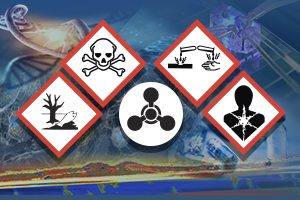Workshop: Predictive Models for Acute Oral Systemic Toxicity

April 11-12, 2018
William H. Natcher Conference Center
National Institutes of Health Bethesda, Maryland, USA
Webcast recordings on NIH Videocast website:
Presentation slides are available below.
NICEATM has released the Collaborative Acute Toxicity Modeling Suite (CATMoS; Mansouri et al. 2021), a free resource for screening organic chemicals for acute oral toxicity. CATMoS is a suite of consensus models developed by combining the results of individual models contributed by workshop participants. It is implemented in v2.0 of OPERA, a free and open-source QSAR tool. OPERA v2.0 can be downloaded from the NIEHS Github repository.
The development of test methods that reduce or replace animal use for acute toxicity tests required by regulatory authorities is one of ICCVAM’s high priority activities. To this end, the ICCVAM Acute Toxicity Workgroup, with support from NICEATM, sponsored a global project to develop in silico models of acute oral systemic toxicity that predict five specific endpoints identified by member regulatory agencies. These endpoints included identification of “very toxic” chemicals (LD50 less than 50 mg/kg), “nontoxic” chemicals (LD50 greater than or equal to 2000 mg/kg), point estimates for LD50s, and categorization of toxicity hazard using the U.S. Environmental Protection Agency and United Nations Globally Harmonized System of Classification and Labelling classification schemes.
NICEATM invited scientists to develop and submit in silico models that predict any or all of these endpoints. This workshop provided an opportunity for project participants to present their submitted models. Workshop participants also discussed developing a consensus model that integrates the submitted models to predict acute oral toxicity, as well as next steps needed to encourage appropriate use of these models in regulatory contexts.
Workshop Presentations
Opening Session
Welcome and Introductions
Nicole Kleinstreuer, NIEHS/NICEATM
Implementation of Non-animal Approaches for Acute Systemic Toxicity
Grace Patlewicz, U.S. Environmental Protection Agency (EPA) National Center for Computational Toxicology
Amended TSCA: EPA's Strategic Plan to Promote the Development and Implementation of Alternative Test Methods
Louis Scarano, EPA Office of Pollution Prevention and Toxics (OPPT)
Regulatory Needs and Decision Contexts for Acute Oral Systemic Toxicity Data
Emily Reinke, U.S. Department of Defense (DoD)
Rat Oral Acute Toxicity Database and Variability
Agnes Karmaus, ILS
Collaborative Modeling Efforts for the Acute Oral Systemic Toxicity Endpoints
Kamel Mansouri, ILS
In Silico Approaches for Acute Oral Toxicity: Session 1
NTP Collaboration on Modeling Acute Systemic Oral Toxicity: Results and Ideas
University of North Carolina, Chapel Hill
Modeling Quantitative Acute Oral Systemic Toxicity Based on a k-Nearest Neighbor (k-NN) Algorithm
Alessandra Roncaglioni, Instituto di Ricerche Farmacologiche "Mario Negri"
Practical Considerations for Estimation of Oral Rat LD50
Todd Martin, EPA Office of Research and Development
UL Cheminformatics Suite
Thomas Luechtefeld, Underwriters Laboratories
Mechanistic Profiling and Mentored Machine Learning: Application to Acute Toxicity
Dan Wilson, The Dow Chemical Company
In Silico Approaches for Acute Oral Toxicity: Session 2
Multitask Deep Learning Modelling of Rodent Acute Toxicity
Alexey Zakharov, National Center for Advancing Translational Sciences
Leadscope Predictive Models for Acute Oral Systemic Toxicity
Glenn Myatt, Leadscope, Inc.
A Clustering-based QSAR Model for Acute Oral Systemic Toxicity
Zhen Zhang, Dow Agrosciences
Consensus Approach for Modeling Acute Systemic Oral Toxicity and LD50 Data Using Machine Learning and In Silico Approaches
Ahmed Sayed, Rosettastein Consulting
Predicting Five Rat Acute Toxicity Endpoints with ANNE Models
Michael Lawless, Simulations Plus, Inc.
Wrap-up of Day One
Donald Cronce, DoD
End User Applications
Overview of the U.S. Strategic Roadmap
Anna Lowit, EPA Office of Pesticide Programs (OPP)
Perspective on the U.S. Army's Uses for Predictive Models of Acute Oral Toxicity
Lyle Burgoon, U.S. Army Engineer Research and Development Center
End User Applications: OECD Landscape
Kristie Sullivan, Physicians Committee for Responsible Medicine
Predictive Models for Acute Oral Systemic Toxicity Workshop: End User Application
Jeffery Gearhart, U.S. Air Force School of Aerospace Medicine
End User Applications: EPA Office of Pesticide Programs
Edward Odenkirchen, EPA OPP
Acute Oral Systemic Toxicity Modeling: End User Applications
Lawrence Milchak, 3M Corporation
End User Applications: EPA Office of Pollution Prevention and Toxics
Louis Scarano, EPA OPPT
Breakout Group Sessions
Charge to the Breakout Groups
Nicole Kleinstreuer, NIEHS/NICEATM
Summary of Breakout Group A: Practical Applications
David Allen, ILS
Summary of Breakout Group B: Interpretation, Characterization, and Extension
Grace Patlewicz, EPA NCCT
Closing Remarks
Nicole Kleinstreuer, NIEHS/NICEATM

